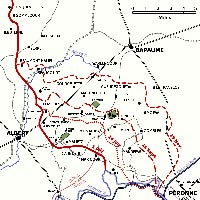
'THE GREAT WAR', 'THE
WAR TO END WAR', 'WORLD WAR 1'
'What passing-bells for these who die as cattle?
- Only the monstrous anger of the guns.'
from
'Anthem for Doomed Youth' by Wilfred Owen
|
THE
BATTLE OF THE SOMME
|
 |
JULY TO NOVEMBER 1916
|
||||||||||||
Preparatory to the 'Big Push', was a week-long continuous bombardment of the enemy lines in an attempt to destroy the German defences and the troops within them. At regular intervals along a line almost 14 miles long, heavy artillery kept up a constant barrage in which it was thought impossible that more than a handful of the enemy could survive.Almost unbelievably, 1,700,000 shells had been rained down on the German lines in a roaring inferno of destruction. In addition, the German positions had been mined and, at zero hour (7:30am), on the 1st of July, a total of 19 mines was detonated under the German positions. However, the German defenders had retreated into deep, reinforced dugouts and bunkers to wait-out the bombardment. When it stopped, they emerged from their hide-outs and with machine guns trained on the slowly advancing lines of troops, mowed them down in their thousands. What followed, for the allies, was a mix of partial success in some sectors and disaster in others. The men of the various battalions had climbed out of their trenches on the command, at 7:30am, with orders to walk, in lines, towards the enemy trenches, in the confident belief that most of the oppositon had been destroyed. They made an easy, slow-moving target for the German machine-gunners as they raked the field. However, the toll of casualties wasn't completely one-sided, Not all the German sections were as strongly defended or as swift to take action, and these units paid a heavy price. The following day the battle continued with attack and counter-attack, a prelude to the months of fighting still to come, as the advantage swung continuously from side to side. September saw the appearance of the first tanks on the battlefield, in the Battle of Flers-Courcelette, from the 15th to the 22nd of September. The outcome was disappointing as these first tanks were largely untested and unreliable; failing to live up to expectations. By late September the weather was beginning to deteriorate and conditions on the battlefields became ever more dreadful. The last battle on the Somme, in 1916, was that of Ancre. It started on November 13th, with the troops having to contend with fog, deep mud and heavy enemy fire. With only partial success, and heavy rain falling, the Battle of the Somme ceased on the 18th of November. What had started as an Allied offensive, to break through enemy lines and bring about a speedy end to the war, degenerated into a series of battles of attrition, with both sides losing hundreds of thousands of men and comparatively little territorial gain. From a German point of view the Battle of the Somme was a disaster in terms of both territorial and troop losses. The German front line had been pushed back (but not broken as initially planned), and their loss of men was almost as great as that of the allied forces. An account of the week-long initial bombardment makes us aware of the toll this took on the Germans both mentally and physically. Yes, the underground bunkers gave protection unless they received a direct hit but a direct hit meant that whole platoons were buried alive. Those that did survive had spent a week underground, with the constant roar of explosions close by and the fear and expectation that the next would obliterate their own bunker. Once the actual battle had begun, allied planes would circle the German positions, seemingly without any German planes being in evidence to chase them away. Their radioed messages to base, identifying strategic positions, were monitored, and the German artillery warned to take cover, but the troops in the frontline trenches were not in contact and couldn't be warned. [Ref:p. 49-50, 'War on the Western Front' ed. by Dr. Gary Sheffield.] It's probably too easy for us to rely on clichéd opinions, such as, "lions led by donkeys", and the like, based on brief descriptions of the battle which don't always give us a clear understanding of the bigger 'picture'. The following links will, hopefully, help us to fill in a few of the gaps.
|
||||||||||||||

